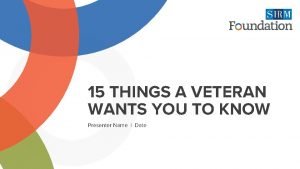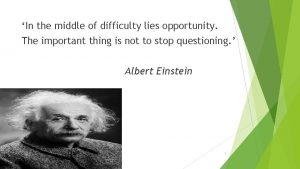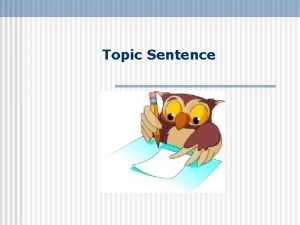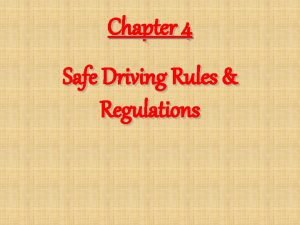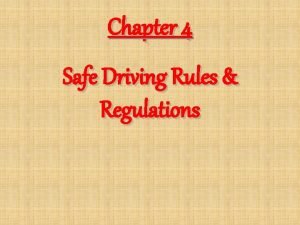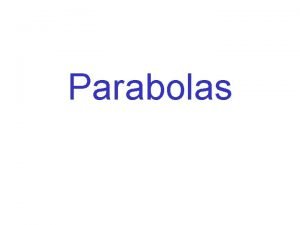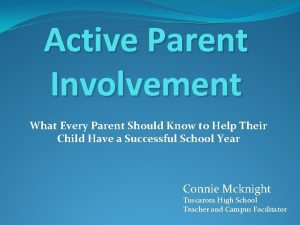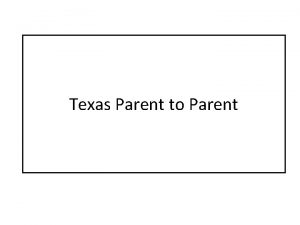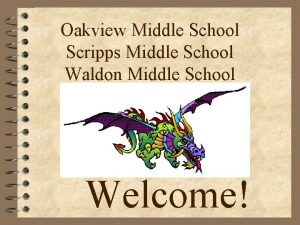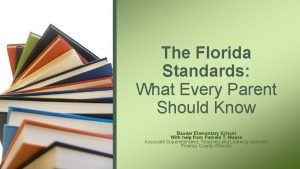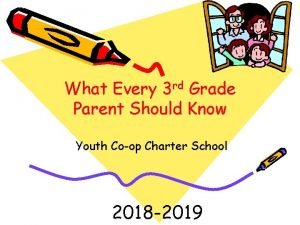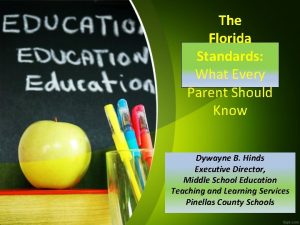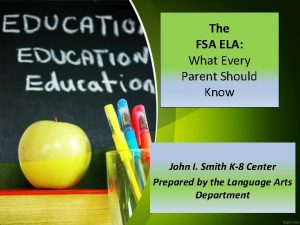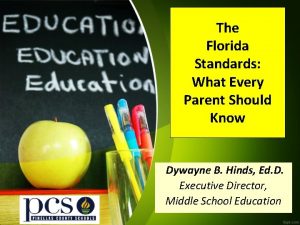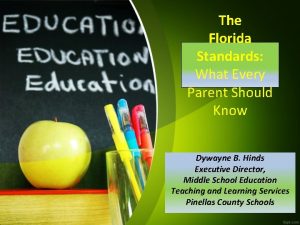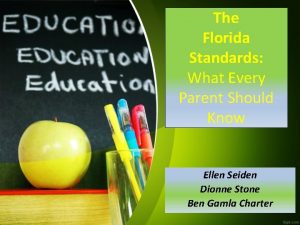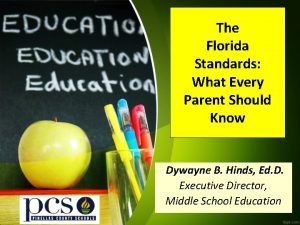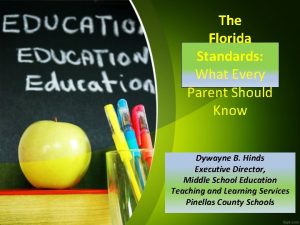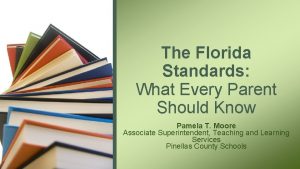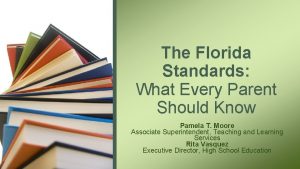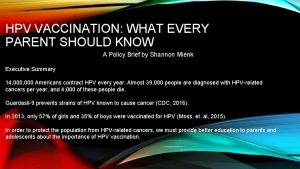MIDDLE SCHOOL 411 WHAT EVERY PARENT SHOULD KNOW



















- Slides: 19

MIDDLE SCHOOL 411 WHAT EVERY PARENT SHOULD KNOW Brooklyn Winters 6 th grade counselor bwinters@wcpss. net

MY ROLE I am an advocate for your student I collaborate with parents and teachers on any support the student needs to be successful and reach his/her full potential Essential Quote: “E Pluribus Unum” or “Out of Many, One”

GOALS FOR MIDDLE SCHOOL Learn to be more self-sufficient Establish good work habits and routines Learn how to be a good friend Explore new things and learn about themselves to start to establish career and educational goals Learn to set goals

WHAT’S HAPPENING TO MY CHILD? Physical changes Emotional changes Social exploration Communication style changes Trying to figure out who they are Desire for more privacy Adjustment to new school and schedule New homework expectations More responsibilities New friends New technology

PHYSICAL CHANGES v. Puberty v. Start to feel self conscious v. Hormones v. Embarrassed by changes in their bodies v. Explore sexuality v. May feel tired, achy, and cranky REASSURE YOUR CHILD THAT THIS IS NORMAL

EMOTIONAL CHANGES v. Wide range of emotions v. Emotional rollercoaster v. Irrational thoughts and feelings v. Desire for more independence You can help by providing support, love, encouragement, and a stable home environment. REASSURE YOUR CHILD THAT THIS IS NORMAL

SOCIAL EXPLORATION v. Distance from family, especially parents v. Making and choosing friends and increased time with friends v. Trying to find their own identity without being different (Want to fit in) v. Peer pressure v. Bullying v. Interaction with older kids v. Greater interest in boyfriends/girlfriends

COMMUNICATION v. Less talking to parents, more talking to friends v. Say things for shock value v. May use disrespectful tones and body language v. Pretend not to hear what you are saying but they are listening

COMMUNICATION – ACTIONS SPEAK LOUDER THAN WORDS v. Listen v. Create opportunities to talk v. Ask open-ended questions v. Talk over differences v. Avoid over-reacting v. Communication with kindness and respect v. Talk about things that are important to your child § § § § School Hobbies Emotions Family Sensitive subjects The future Current pop culture events

ALLOW FOR INDEPENDENCE v. This is normal v. Don’t feel rejected v. Be available without dominating your child’s new independent identity

AVOID POWER STRUGGLES v. They may challenge you constantly v. Provide consistent boundaries v. Keep open, negotiable lines of communication v. They can feel embarrassed, inadequate, resentful, and bitter when they feel like they are being overpowered v. You don’t always have to be right as the parent

HELP YOUR CHILD WITH ACADEMICS v. Pay attention to their school work by looking at their homework and notebooks v. Use Power School account regularly v. Don’t wait until there’s a problem to ask questions v. Promote good health habits like going to bed on time and eating well v. Stimulate your child’s interests v. Be positive about education v. Help set academic goals v. Insist on daily attendance v. Provide a quiet study area at home v. Offer praise Increases self-esteem

HELP YOUR CHILD FIND BALANCE v. Encourage agenda use v. Limit TV, computer, phone, games, and other technology v Learn about this technology v. Promote proper rest and nutrition v. Encourage making “TO DO LISTS” v. Help child prioritize and organize v. Don’t let your child take on too much v. Teach your child to break large projects into smaller projects v. PERFECTION IS NOT NECESSARY

HELP YOUR CHILD WITH STRESS v. Body Basics- Help Recognize changes Tight fists Clenched jaws Butterflies in stomach Sweaty palms Trouble concentrating v. Breathing (usually shallow when stressed) Can help to calm body if deep breathing occurs v. Be Aware Changing negative thoughts to positive thoughts will help to reduce stress Model this for your child

HELP YOUR CHILD WITH FRIENDS v. FOLLOW THE GOLDEN RULE v. Foster self respect and confidence v. Teach children manners/showing respect for others. v. Coach children on social situations. v. Foster empathy with others. v. Help children “read” facial expressions. v. Monitor social lives, especially through social media. v. When possible, allow children to work out their own problems. v. Be aware of bullying. v. Be aware of cultural differences.

A NOTE ON BULLYING Bullying Prevention Month is October Bullying Definition - School Board Policy 6414 A. Definition of Harassment and Bullying 1. As used in this policy, harassing or bullying behavior is any repeated, systematic pattern of gestures or written, electronic, or verbal communications, or any physical act or any threatening communication on school property; at any school sponsored function; on a school bus; or as otherwise stated in Board Policy 6400 - Student Code of Conduct, and that: a. Places a student or school employee in actual and reasonable fear of harm to his or her person or damage to his or her property; or b. Creates or is certain to create a hostile environment by substantially interfering with or impairing a student’s educational performance, opportunities, or benefits. A hostile environment means that the victim subjectively views the conduct as bullying or harassing behavior and the conduct is objectively severe or pervasive enough that a reasonable person would agree that it is bullying or harassing behavior. 2. Harassing or bullying behavior includes, but is not limited to, acts reasonably perceived as being motivated by any actual or perceived differentiating characteristic, such as race, color, religion, ancestry, national origin, gender, socioeconomic status, academic status, gender identity, physical appearance, sexual orientation, or mental, physical, developmental, or sensory disability, or by association with a person who has

HELP YOUR CHILD WITH PEER PRESSURE Teach your child to : v. Be prepared to deal with uncomfortable situations. v. Practice saying NO!! v. Avoid friends and situations that make you uncomfortable. v. Be proud of saying NO! v. Stand up for what is right. v. Help other friends make the right choice.

PARENT-TEACHER CONFERENCE DISCUSSION POINTS v. Homework v. Class Participation v. Organization v. Academic Success v. Classroom Time Management v. Attendance and Punctuality v. Focus v. Social Adjustment v. Strengths and Weaknesses v. And anything else that concerns you

QUESTIONS / HELP/ CONCERNS Brooklyn Winters Altonia Bransome 6 th grade counselor 6 th grade Asst. Principal 919. 501. 7990 919. 850. 8769 Main School Number - 919. 850. 8755 TIP LINE – 919. 850. 1991
 What should every efl teacher know
What should every efl teacher know Gossip girl every parent's nightmare
Gossip girl every parent's nightmare Every country and every nation
Every country and every nation Microsoft mission statement
Microsoft mission statement Every knee shall bow every tongue confess
Every knee shall bow every tongue confess Every rotarian every year
Every rotarian every year Every nation and every country
Every nation and every country Every picture has a story and every story has a moment
Every picture has a story and every story has a moment Every child every day
Every child every day 15 things every veteran wants you to know
15 things every veteran wants you to know Know history know self
Know history know self Do deep generative models know what they don’t know?
Do deep generative models know what they don’t know? I'm holding on to your promises you are faithful
I'm holding on to your promises you are faithful In the middle of difficulty lies opportunity.
In the middle of difficulty lies opportunity. Personal care skills chapter 6
Personal care skills chapter 6 Topic sentence in paragraph
Topic sentence in paragraph Jeff dean google
Jeff dean google A motorist should know that he/she is entering
A motorist should know that he/she is entering If a motorist’s vehicle becomes disabled he/she must?
If a motorist’s vehicle becomes disabled he/she must? Parabola equation
Parabola equation









